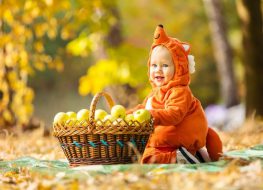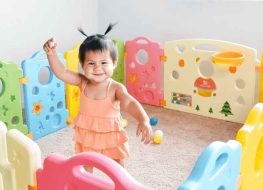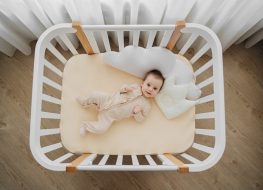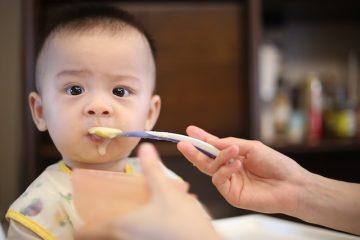
Your baby needs a lot of nutrients in order to grow strong and avoid sickness. Hence, you should make their eating time as enjoyable as possible. Using a baby bib can be the best way to ensure your child is clean and comfortable during mealtimes because it’s easy to use and helps reduce messes.
A baby bib is a small, cotton, and polyester garment with a large neckband, usually made in pink or blue color, worn by infants and young children to keep their clothes clean. Bibs are often used as a first step into potty training. If you’re a first-time parent, this article will guide you on how and what to buy when getting baby bibs.
Why Should You Consider Using a Bib?
A good bib not only helps keep your baby clean but also prevents drool and food from getting on their clothes. It can function as a pacifier holder, calming device, or toy and helps give a sense of responsibility to your little one, which will help them develop good habits in the future.
There are many different styles of bibs, so choose one that fits your baby’s needs and style. Here are several reasons to consider using a bib:
- If your baby spills juice on their shirt, the bib will absorb most of the liquid and help prevent stains.
- Bibs can protect your little one’s neck from getting covered in food or drink. If there is a mess, simply take off the bib and put it in the washing machine with the clothes.
- A bib can be used for many years, even after your child outgrows their baby clothes. It’s an affordable way to keep your child safe and presentable all at once!
- Giving them a bib every time they have an accident can help teach them how to be more careful.
How Do Bibs Help Babies?
It’s easy for babies to make a huge mess when they eat, whether it be food or breast milk. A baby bib should be given during this period to help capture any bits of liquid that get spilled and keep the area dry.
Excessive drool is likely to happen when your baby starts growing teeth. A teething bib will aid the baby in its teething period and avoid excess drool.
As your baby grows, they will eat significantly more. Hence, you should give them a feeding bib to lessen food wastage. If your little one is always on the go, a silicone bib with a spill pocket can catch any food they might drop.
Different Types of Bibs According to Use
There are several types of bibs, with each one serving its specific purposes for certain situations. Here are some of the best baby bibs you might need in the future for your baby:
Infant Bibs
Infant bibs can prevent dripping while breastfeeding or bottle feeding. You can use them to clean the baby’s face and catch any dribbled milk.
Good quality bibs have a cotton front, which provides extra softness and absorbency. The neck has two fasteners that make it easy to put on while also providing flexibility. There are baby bibs designed for infants as little as one week old and as old as two years.
Large Bibs
Large bibs, also called toddler bibs, are longer and wider compared to regular bibs. They’re often worn as an extended bib. These are great options when introducing solid foods to infants and protecting their clothes from stains. They’re also useful for bigger babies.
Large-sized bibs are suitable for infants aged three months to two years and provide extra protection.
Teething Bibs
A teething bib resembles a dribbling bib, except it has a silicone triangle sewn into the bottom to give the baby a teething aid. Teething bibs can be used on teething babies as early as three months old and as late as two years. They have a silicone teether attached to the bottom of the front side of the bib.
Feeding Bibs
A feeding bib becomes necessary whenever a baby graduates from breast milk or formula to table foods. It is also smaller than a feeding bib.
Instead of being soft and absorbent, feeding bibs are designed to withstand stains and the general chaos when a baby first starts eating solid foods. Silicone baby bibs are resistant to stains and can be easily and quickly cleaned.
Children as young as six months and as old as three years can benefit from them.
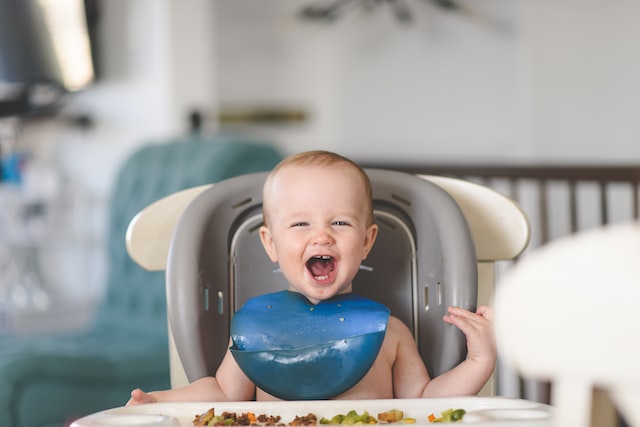
4 Factos to Consider When Buying Baby Bibs
Size
Many parents don’t know that baby bibs come in different sizes to accommodate children of various ages. For example, you can tell a toddler bib from a newborn bib because it will be larger and likely have a pocket to collect spilled food.
For your newborn child, go for smaller sizes like infant bibs. On the other hand, if you have a toddler, large bibs are a good option for catching spills from the baby spoon during feeding time. All you need is a bib that can protect your kid from spills and mess.
Material
Many baby bibs are available in either a cloth-like fabric or silicone. Pick the fabric you think your child will be most comfortable with. Every choice has its advantages and disadvantages, so choose based on your needs.
Cloth bibs, for instance, are machine-washed, while silicone bibs can be cleaned in the sink with soap and water. If you’re busy and just need a quick cleanup, silicone bibs will be convenient for you.
Features
The main purpose of baby bibs is to protect your child and their clothes from spilled drinks and food. These are not just ordinary spills since they can stain clothes and permanently destroy the fabric.
Modern bibs offer innovative features such as adjustable snaps, which are beneficial for growing babies, and food catchers that can help prevent even the biggest chunks of food from falling.
Price
When it comes to baby expenses, it is understandable that money can be scarce, but bibs are among the least expensive items you can buy.
When the figures are weighed in, bibs prove to be a worthwhile purchase. Instead of constantly replacing clothes ruined by excessive salivation, it’s more cost-effective to buy bibs that can protect your baby’s clothes.
Having a supply of bibs on hand can also help you avoid doing loads and loads of laundry simply to keep your baby clean and dry.
How to Take Care of Baby Bibs
Bibs are one of the most important pieces of clothing a baby can have. But they can get dirty quickly, so take care of them.
- Keep your baby’s bibs clean by storing them in a cool, dry place where they are easy to grab if needed.
- Make sure they are always fit. Bibs should fit tightly around your baby’s neck and be long enough to cover their shoulder blades when they are wearing them.
- It is recommended to handwash baby bibs rather than using a washing machine since it can destroy bibs with sensitive materials.
Choose the Best Bib For Your Baby From Ashtonbee!
If you’re looking for the best bib for your little one, we’ve got the answer for you.
Ashtonbee’s Silicon Baby Bib has a wide pocket to catch food, crumbs, and liquids. Since the bib is made from silicon, it is resistant to stains and doesn’t absorb water. You can effortlessly wash it away with soap and water after use. Storing it becomes easy because you can easily roll it to fit in between your things.
Lastly, the materials used are toxic-free. That’s why you shouldn’t worry that your child may intake chemicals from the bib! If you’re looking for a way to make your child’s life a little easier, you can check our collection for other baby essentials!

